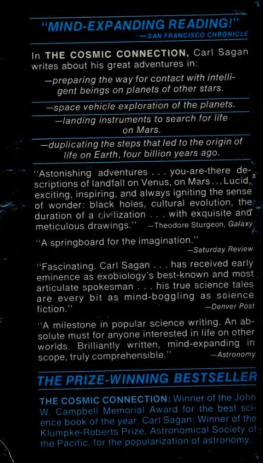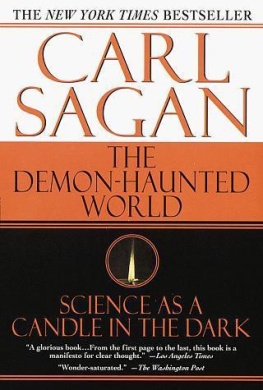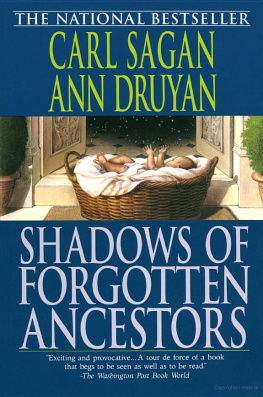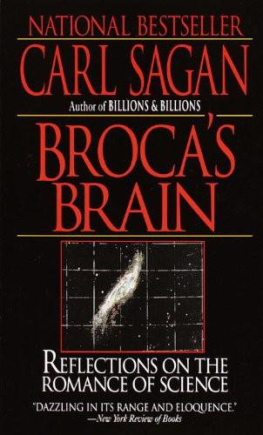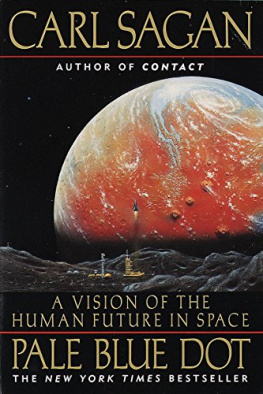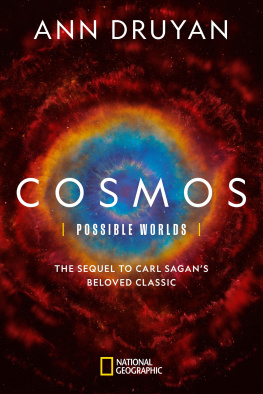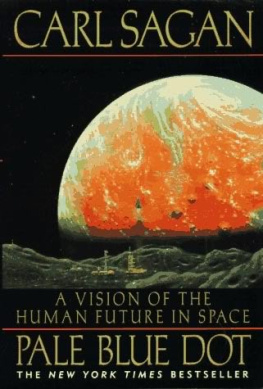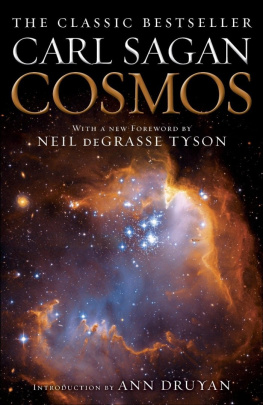Dr. Carl Sagan, the author of The Cosmic Connection , is Professor of Astronomy and Space Sciences and Director of the Laboratory for Planetary Studies at Cornell University. He received NASAs Medal for Exceptional Scientific Achievement for his studies of Mars with Mariner 9; he was responsible for placing the message from Earth aboard the interstellar spacecraft Pioneer 10 ; and he chaired the U.S. delegation to the U.S./U.S.S.R. Conference on Communication with Extraterrestrial Intelligence. Dr. Sagan was awarded in 1973 the Prix Galabertthe international astronautics prize. He is editor of the planetary science journal Icarus and is widely known for his studies of the planets, the origin of life, and the prospects for life beyond the Earth. He is formerly of the Harvard, Caltech and Stanford Medical School faculties.
Jerome Agel is the producer of The Cosmic Connection . His fourteen book productions include: Herman Kahnsciousness , Understanding Understanding (with Humphrey Osmond), The Medium Is the Massage (with Marshall McLuhan), The Making of Kubricks 2001, Is Today Tomorrow? (a synergistic collage of alternative futures), I Seem to Be a Verb (with Buckminster Fuller), A World Without What Our Presidents Didnt Know , Surprising Facts About U.S. History , Right on Time (with Alan Lakein), The Fasting Diet: How to Lose Weight Without Eating (with Allan Cott), and Rough Times .
Illustration on title page: A spiral galaxy with representative Type I, Type II, and Type III civilizations indicated. By Jon Lomberg.
Preface
W hen I was twelve, my grandfather asked methrough a translator (he had never learned much English)what I wanted to be when I grew up. I answered, An astronomer, which, after a while, was also translated. Yes, he replied, but how will you make a living?
I had supposed that, like all the adult men I knew, I would be consigned to a dull, repetitive, and uncreative job, astronomy would be done on weekends. It was not until my second year in high school that I discovered that some astronomers were paid to pursue their passion. I was overwhelmed with joy; I could pursue my interest full-time.
Even today, there are moments when what I do seems to me like an improbable, if unusually pleasant, dream: To be involved in the exploration of Venus, Mars, Jupiter, and Saturn; to try to duplicate the steps that led to the origin of life four billion years ago on an Earth very different from the one we know; to land instruments on Mars to search there for life; and perhaps to be engaged in a serious effort to communicate with other intelligent beings, if such there be, out there in the dark of the night sky.
Had I been born fifty years earlier, I could have pursued none of these activities. They were then all figments of the speculative imagination. Had I been born fifty years later, I also could not have been involved in these efforts, except possibly the last, because fifty years from now the preliminary reconnaissance of the Solar System, the search for life on Mars, and the study of the origin of life will have been completed. I think myself extraordinarily fortunate to be alive at the one moment in the history of mankind when such ventures are being undertaken.
So when Jerome Agel approached me about doing a popular book to try to communicate my sense of the excitement and importance of these adventures, I was amenableeven though his suggestion came just before the Mariner 9 mission to Mars, which I knew would occupy most of my waking hours for many months. At a later time, after discussing communication with extraterrestrial intelligence, Agel and I had dinner in a Polynesian restaurant in Boston. My fortune cookie announced, You will shortly be called upon to decipher an important message. This seemed a good omen.
After centuries of muddy surmise, unfettered speculation, stodgy conservatism, and unimaginative disinterest, the subject of extraterrestrial life has finally come of age. It has now reached a practical stage where it can be pursued by rigorous scientific techniques, where it has achieved scientific respectability and where its significance is widely understood. Extraterrestrial life is an idea whose time has come.
This book is divided into three major sections. In the first part I try in several ways to convey a sense of cosmic perspectiveliving out our lives on a tiny hunk of rock and metal circling one of 250 billion stars that make up our galaxy in a universe of billions of galaxies. The deflation of some of our more common conceits is one of the practical applications of astronomy. The second part of the book is concerned with various aspects of our Solar Systemmostly with Earth, Mars, and Venus. Some of the results and implications of Mariner 9 can be found here. Part Three is devoted to the possibility of communicating with extraterrestrial intelligence on planets of other stars. Since no such contact has yet been madeour efforts to date have been feeblethis section is necessarily speculative. I have not hesitated to speculate within what I perceive to be the bounds of scientific plausibility. And, although I am not by training a philosopher or sociologist or historian, I have not hesitated to draw philosophical or social or historical implications of astronomy and space exploration.
The astronomical discoveries we are in the midst of making are of the broadest human significance. If this book plays a small role in broadening public consideration of these exploratory ventures, it will have served its purpose.
As with all ongoing work and especially all speculative subjects, some of the statements in these pages will elicit vigorous demurrers. There are other books with other opinions. Reasoned disputation is the lifeblood of scienceas is, sadly, infrequently the case in the intellectually more anemic arena of politics. But I believe that the more controversial opinions expressed here have, nevertheless, a significant scientific constituency. I have purposely introduced the same concept in slightly different contexts in a few places where I felt the discussion required it. The book is carefully structured, but, for the reader who wishes to browse ahead, most chapters are self-contained.
There are far too many who helped shape my opinions on these subjects for me to thank them all here. But in rereading these chapters, I find I owe a special debt to Joseph Veverka and Frank Drake, both of Cornell University, with whom over the past few years I have discussed so many aspects of this volume. The book was composed partly during a very long transcontinental trip in a very short automobile. I thank Linda and Nicholas for their encouragement and patience. I am also grateful to Linda for drawing two handsome humans and one elegant unicorn. And I am grateful to the late Mauritz Escher for permission to reproduce his Another World and to Robert Macintyre for the human figure and star field in Part Three. Jon Lombergs paintings and drawings have been a source of intellectual and aesthetic excitement for me, and I am grateful to him for producing many of them especially for this book. Hermann Ecklemans careful photographic reproductions of Lombergs work have facilitated their appearance in this book. And I thank Jerome Agel, without whose time and persistence this book would never have been written.
I am indebted to John Naugle of NASA for showing me his file on public response to the Pioneer 10 plaque; the Oregon System of Higher Education for permission to reproduce some ideas from my book Planetary Exploration ; the Forum for Contemporary History, in Santa Barbara, for permission to reproduce a portion of my letter distributed by the Forum in January 1973; and Cornell University Press for permission to reprint a fraction of my chapter The Extraterrestrial and Other Hypotheses from UFOs: A Scientific Debate , edited by Carl Sagan and Thornton Page, Cornell University Press, 1972. I am also grateful to those who have granted me permission to reproduce in Chapter 4 their remarks on the Pioneer 10 plaque. The evolution of this book through many drafts owes much to the technical skills of Jo Ann Cowan, and, especially, Mary Szymanski.
Next page
